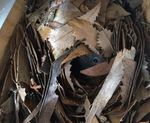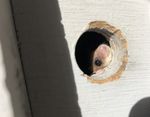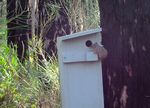Building nest boxes after fire - Landscape South Australia
←
→
Page content transcription
If your browser does not render page correctly, please read the page content below
Building nest boxes after fire
Fact sheet | March 2020
Bushfires can cause the short term loss of habitat
for some native fauna species, including those that
rely on tree hollows. If trees with hollows are lost
from your area, nest boxes can be a great short to
medium term option to help provide these
essential resources. The trick is to know which
species you need to focus on for a particular site,
and what kind of nest box is suitable.
The importance of hollow-bearing trees
Natural tree hollows are extremely valuable for many native
wildlife species and essential for the long-term viability of many
wildlife populations. They provide roosting and breeding sites,
offering shelter and protection from the elements and predators.
Approximately 30% of Australia’s terrestrial mammals, 60% of
micro-bat species and 15% of bird species depend on hollows for
roosting, nesting or food. Some species (e.g. brown treecreeper,
laughing kookaburra) need hollows to continue to persist in the
landscape. Others, such as pygmy possums will seek out hollows
but can use alternate shelter if hollows are not available.
A yellow-tailed black cockatoo nesting tree (Eucalyptus dalrympleana)
collapsed after the Cudlee Creek fire, 2019 Photo Kieran Brewer
Natural hollows range from small cracks, just a few millimetres
Australia has the highest rate wide, to large ones which may be 50 cm or more wide, and
of hollow dependency in world, several metres deep. Hollows can occur in the trunk, limbs or
with over 300 native vertebrate stumps, and entrances can be at any height. Cavity dependant
wildlife rely primarily on Eucalyptus species and these trees
species relying on hollows in
provide essential habitat when alive, but dead standing stags
some form. are just as important.
Hollows can take 100s of years to develop, and we are losing
them faster than they are being replaced. Fire can be a benefit
and detriment to hollow bearing trees; it can assist in the creation
of hollows, however trees that already have hollows are more
susceptible to collapse after a fire.
The role of nest boxes
Artificial habitat for hollow-reliant wildlife can be created by
installing nest boxes that mimic the shape and size of natural
hollows. However, nest boxes are not a true substitute for these
hollows, so it is vital to protect trees that have them, including
dead, standing trees and fallen timber. Consideration for those
trees that will form the next generation of hollows is also essential.
There is still a lot to learn about nest boxes and how they might
contribute to conservation after fire, especially as resources like
food may also be limited, so location will be important.
If you want to provide artificial hollows on your property
A western pygmy possum (Concinnus cercartetus) peers out from after a fire, it is important you do some research first.
its nest box Photo Elisa Sparrow
Here is some information to help you get the best results.2 | Building nest boxes after fire
Nest box tips Target species
Each species has different nest box requirements such as height,
Maintenance width and depth. One important consideration is the size of the
Nest boxes require maintenance, they are not just a “set entrance hole. The hole needs to be just large enough for the
and forget” project. They need to be checked at least a animal to enter, but small enough to exclude bigger animals
few times a year for use by feral animals (e.g. European which may predate on the occupants, or be more dominant.
honey bees, European starlings and common mynahs), Boxes for some species may require features such as drainage
fastening screws and/or chains changed, and the general to avoid drowning, sacrificial chewing posts, and ladders for exit
integrity of the structure examined. This is not always an and entry. Investigate the requirements for your target species
easy task given the height of the boxes. first. The table below, adapted from Faunature, is a good guide
for the approximate dimensions required for various species.
Fire impact on hollow-bearing trees
Look around your property and think about what type The addition of most well-constructed nesting boxes will be
of species were there before the fire and how the fire beneficial. Common species are likely to be the quickest to take
impacted on their habitat trees. Is there a need to provide up residence in these new homes. Threatened species may take
artificial hollows? For example, if you have yellow-tailed longer, however supporting this rare wildlife is particularly
black cockatoos nesting in trees, are the trees still there rewarding, and of greatest benefit to the environment. When
or have they collapsed? deciding what species to target, also consider those that may be
Smaller species like pardalotes, yellow-footed antechinus “undesirable” in certain settings. For example, if vineyards or
and microbats rely on hollows with a small entrance to orchards are nearby, try and avoid attracting fruit eating species.
protect them from predators. Do the hollows suit these Instead you could choose to attract insectivorous or carnivorous
small species or have the entrances been enlarged due species like pardalotes, kookaburras, owls or nightjars. This may
to fire? be especially important after a fire, as recovering crops are
already under pressure.
Nest box requirements for native species
Wildlife species Orientation Height (cm) Depth (cm) Entrance hole (cm) Above ground (m)
Pardalotes - 10 10 3 1+
Tree martin
Grey shrike-thrush - 25 18 9x9 2+
Microbats Vertical 30 15 1.2 – 1.5 4+
Pygmy possums Vertical 30 15 2 1.5 – 5
Yellow-footed antechinus 3
Small parrots Either 50 15 4.5 4+
Tree creepers 6
Owlet nightjars 8
Medium parrots Either 55 20 7 4+
Brushtail and ringtail Either 45 25 10 4+
possums
Small ducks Horizontal 45 35 10 – 15 2+
Kookaburra Horizontal 30 30 12 x 18 4+
Barn owl Horizontal 40 40 22 x 15 6+
Cockatoos* Vertical 100 40 18 10+
*Yellow-tailed black cockatoos prefer a different type of design, similar to Carnaby’s cockatoos www.dpaw.wa.gov.au/images/plants-animals/threatened-species/carnabys_
artificial_hollows_-_design_and_place_2015.pdf3 | Building nest boxes after fire
Box design
Nest boxes can be purchased from State Flora (Belair and
Murray Bridge), Cleland Wildlife Park and Faunature.
www.faunature.com.au
Or make your own. Do your research first though, to ensure you
are building boxes to attract the species you want. Consider the
entrance hole size, species requirements and more, as discussed
earlier. There are many resources online, including:
https://nestboxtales.com
https://nestboxtales.com/wp-content/uploads/2020/02/
NestBoxPack-AdelaideHills-BushfireZone.pdf
www.birdsinbackyards.net/Nest-Box-Plans
www.backyardbuddies.org.au/habitats/build-a-microbat-
roost-box
www.wildlifevictoria.org.au/images/How_to_Build_a_
Possum_Nest_Box.pdf
Placement of boxes
Correct placement of the boxes will increase your chances of
success, so understanding the habitat preferences and behaviour
of the species you are trying to attract will be important. For
example, microbats need at least 3 m of clear space below the
box entrance (e.g. no large tree limbs or shrubs) so they can fly
into the box.
Other points to consider:
Food availability: after a fire, food is limited, and it may take
years for severely burnt trees to flower again. Consider placing
nest boxes in locations where trees are less impacted e.g. in/near
an unburnt patch of vegetation, or where the canopy is still intact.
Putting boxes in/near these intact areas will also help provide
A yellow-footed antechinus (Antechinus flavipes) explores a nest box
protection from the weather (e.g. sun, rain). This is especially (above) and makes a nest inside a box (top) Photos Elisa Sparrow
important for species like yellow-tailed black cockatoos where the
top of the nest box may be open. can be oriented from south to northeast. In contrast, microbats
Tree selection: attach the box to a tree species that would prefer a north to north-westerly aspect as the heat from the
normally be used, avoiding significantly damaged trees which may afternoon sun will help raise the bat’s body temperature in
not support the box in the long term. preparation for night-time flight.
Height: distance from the ground varies (see the table in this fact Patience
sheet). The box needs to be high enough to avoid predation from Wait and observe. Patience is important with nest boxes,
cats, rats and foxes but low enough to allow access for especially after a fire. Food resources are limited and will influence
maintenance. what species return and when. The box may remain unoccupied
Angles: install boxes vertically or on a slightly angled forward for a few years, however once found many species will continue
trunk to reduce rainwater entry. to use the same hollow for consecutive years.
Installation: some of the large boxes will potentially need Handling wildlife
someone with qualifications in tree climbing (e.g. arborist) to Please do not handle or disturb wildlife. The boxes are there
install. Again, take care to avoid trees that may be structurally to protect them, even from those of us who are well meaning. If
damaged. you have to perform maintenance, wait until the inhabitants have
Orientation: this may differ in each location and with the species left the box.
you want to attract. For most species you will be looking to avoid There is plenty of information online if you want to learn more.
the hot north and westerly sun, together with the wet south to However, if you have a specific question please contact your local
south-westerly winds. Birds and most mammals prefer a box natural resources centre.
facing in an easterly direction, however depending on the tree itA striated pardalote
(Pardalotus striatus) is a
small insectivorous bird
that nests in hollows
Photo Martin Stokes
References Further information, contact your local
Franks, A and Franks, S (2006) Nest boxes for wildlife: A practical Natural Resources Centre:
guide. Bloomings Books.
Gawler (08) 8115 4600
Gibbons, P & Lindenmayer, D (2002) Trees hollows and wildlife
Black Hill (08) 8336 0901
conservation in Australia. CSIRO Publishing, Collingwood,
Victoria. Willunga (08) 8550 3400
www.ari.vic.gov.au/research/people-and-nature/use-of-nest- Mount Barker (08) 8391 7500
boxes-in-victoria www.naturalresources.sa.gov.au/adelaidemtloftyranges
www.faunature.com.au www.naturalresources.sa.gov.au/samurraydarlingbasin
96048You can also read
























































